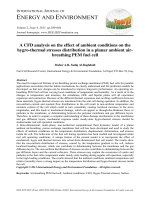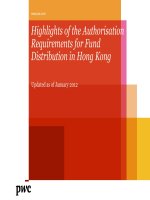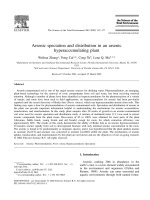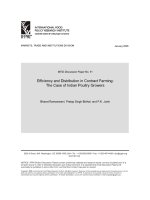Distribution in low-voltage installations
Bạn đang xem bản rút gọn của tài liệu. Xem và tải ngay bản đầy đủ của tài liệu tại đây (706.77 KB, 10 trang )
Schneider Electric - Electrical installation guide 2010
E15
© Schneider Electric - all rights reserved
E - Distribution in low-voltage installations
2 The installation system
2.1 Distribution switchboards
A distribution switchboard is the point at which an incoming-power supply divides
into separate circuits, each of which is controlled and protected by the fuses or
switchgear of the switchboard. A distribution switchboard is divided into a number
of functional units, each comprising all the electrical and mechanical elements
that contribute to the fulfilment of a given function. It represents a key link in the
dependability chain.
Consequently, the type of distribution switchboard must be perfectly adapted to its
application. Its design and construction must comply with applicable standards and
working practises.
The distribution switchboard enclosure provides dual protection:
b Protection of switchgear, indicating instruments, relays, fusegear, etc. against
mechanical impacts, vibrations and other external influences likely to interfere with
operational integrity (EMI, dust, moisture, vermin, etc.)
b The protection of human life against the possibility of direct and indirect electric
shock (see degree of protection IP and the IK index in section 3.3 of Chapter E).
Types of distribution switchboards
Distribution switchboards may differ according to the kind of application and the
design principle adopted (notably in the arrangement of the busbars).
Distribution switchboards according to specific applications
The principal types of distribution switchboards are:
b The main LV switchboard - MLVS - (see Fig. E27a)
b Motor control centres - MCC - (see Fig. E27b)
b Sub-distribution switchboards (see Fig. E28)
b Final distribution switchboards (see Fig. E29)
Distribution switchboards for specific applications (e.g. heating, lifts, industrial
processes) can be located:
b Adjacent to the main LV switchboard, or
b Near the application concerned
Sub-distribution and final distribution switchboards are generally distributed
throughout the site.
Distribution switchboards, including the main
LV switchboard (MLVS), are critical to the
dependability of an electrical installation.
They must comply with well-defined standards
governing the design and construction of
LV switchgear assemblies
The load requirements dictate the type of
distribution switchboard to be installed
Fig. E27 : [a] A main LV switchboard - MLVS - (Prisma Plus P) with incoming circuits in the form
of busways - [b] A LV motor control centre - MCC - (Okken)
Fig. E28 : A sub-distribution switchboard (Prisma Plus G)
Fig. E29 : Final distribution switchboards [a] Prisma Plus G Pack; [b] Kaedra; [c] mini-Pragma
a b c
a b
EIG_chap_E-2010.indb 15 04/12/2009 11:52:12
Schneider Electric - Electrical installation guide 2010
E - Distribution in low-voltage installations
E16
© Schneider Electric - all rights reserved
Two technologies of distribution switchboards
Traditional distribution switchboards
Switchgear and fusegear, etc. are normally located on a chassis at the rear of the
enclosure. Indications and control devices (meters, lamps, pushbuttons, etc.) are
mounted on the front face of the switchboard.
The placement of the components within the enclosure requires very careful study,
taking into account the dimensions of each item, the connections to be made to it,
and the clearances necessary to ensure safe and trouble-free operation. .
Functional distribution switchboards
Generally dedicated to specific applications, these distribution switchboards are
made up of functional modules that include switchgear devices together with
standardised accessories for mounting and connections, ensuring a high level of
reliability and a great capacity for last-minute and future changes.
b Many advantages
The use of functional distribution switchboards has spread to all levels of LV
electrical distribution, from the main LV switchboard (MLVS) to final distribution
switchboards, due to their many advantages:
v System modularity that makes it possible to integrate numerous functions in a
single distribution switchboard, including protection, control, technical management
and monitoring of electrical installations. Modular design also enhances distribution
switchboard maintenance, operation and upgrades
v Distribution switchboard design is fast because it simply involves adding functional
modules
v Prefabricated components can be mounted faster
v Finally, these distribution switchboards are subjected to type tests that ensure a
high degree of dependability.
The new Prisma Plus G and P ranges of functional distribution switchboards from
Schneider Electric cover needs up to 3200 A and offer:
v Flexibility and ease in building distribution switchboards
v Certification of a distribution switchboard complying with standard IEC 60439 and
the assurance of servicing under safe conditions
v Time savings at all stages, from design to installation, operation and modifications
or upgrades
v Easy adaptation, for example to meet the specific work habits and standards in
different countries
Figures E27a, E28 and E29 show examples of functional distribution switchboards
ranging for all power ratings and figure E27b shows a high-power industrial functional
distribution switchboard.
b Main types of functional units
Three basic technologies are used in functional distribution switchboards.
v Fixed functional units (see Fig. E30)
These units cannot be isolated from the supply so that any intervention for
maintenance, modifications and so on, requires the shutdown of the entire
distribution switchboard. Plug-in or withdrawable devices can however be used to
minimise shutdown times and improve the availability of the rest of the installation.
v Disconnectable functional units (see Fig. E31)
Each functional unit is mounted on a removable mounting plate and provided with a
means of isolation on the upstream side (busbars) and disconnecting facilities on the
downstream (outgoing circuit) side. The complete unit can therefore be removed for
servicing, without requiring a general shutdown.
v Drawer-type withdrawable functional units (see Fig. E32)
The switchgear and associated accessories for a complete function are mounted on
a drawer-type horizontally withdrawable chassis. The function is generally complex
and often concerns motor control.
Isolation is possible on both the upstream and downstream sides by the complete
withdrawal of the drawer, allowing fast replacement of a faulty unit without de-
energising the rest of the distribution switchboard.
A distinction is made between:
b Traditional distribution switchboards in which
switchgear and fusegear, etc. are fixed to a
chassis at the rear of an enclosure
b Functional distribution switchboards for
specific applications, based on modular and
standardised design.
Fig. E30 : Assembly of a final distribution switchboard with
fixed functional units (Prisma Plus G)
Fig. E31 :
Distribution switchboard with disconnectable
functional units
Fig. E32 : Distribution switchboard with withdrawable functional
units in drawers
EIG_chap_E-2010.indb 16 04/12/2009 11:52:13
Schneider Electric - Electrical installation guide 2010
E17
© Schneider Electric - all rights reserved
Standards
Different standards
Certain types of distribution switchboards (in particular, functional distribution
switchboards) must comply with specific standards according to the application or
environment involved.
The reference international standard is IEC 60439-1 type-tested and partially type-
tested assemblies
Standard IEC 60439-1
b Categories of assemblies
Standard IEC 60439-1 distinguishes between two categories of assemblies:
v Type-tested LV switchgear and controlgear assemblies (TTA), which do not diverge
significantly from an established type or system for which conformity is ensured by
the type tests provided in the standard
v Partially type-tested LV switchgear and controlgear assemblies (PTTA), which may
contain non-type-tested arrangements provided that the latter are derived from type-
tested arrangements
When implemented in compliance with professional work standards and
manufacturer instructions by qualified personnel, they offer the same level of safety
and quality.
b Functional units
The same standard defines functional units:
v Part of an assembly comprising all the electrical and mechanical elements that
contribute to the fulfilment of the same function
v The distribution switchboard includes an incoming functional unit and one or more
functional units for outgoing circuits, depending on the operating requirements of the
installation
What is more, distribution switchboard technologies use functional units that may be
fixed, disconnectable or withdrawable (see section 3.1 of Chapter E).
b Forms (see Fig. E33)
Separation of functional units within the assembly is provided by forms that are
specified for different types of operation.
The various forms are numbered from 1 to 4 with variations labelled “a” or “b”. Each
step up (from 1 to 4) is cumulative, i.e. a form with a higher number includes the
characteristics of forms with lower numbers. The standard distinguishes:
v Form 1: No separation
v Form 2: Separation of busbars from the functional units
v Form 3: Separation of busbars from the functional units and separation of all
functional units, one from another, except at their output terminals
v Form 4: As for Form 3, but including separation of the outgoing terminals of all
functional units, one from another
The decision on which form to implement results from an agreement between the
manufacturer and the user.
The Prima Plus functional range offers solutions for forms 1, 2b, 3b, 4a, 4b.
Compliance with applicable standards is
essential in order to ensure an adequate
degree of dependability
Three elements of standard IEC 60439-1
contribute significantly to dependability:
b Clear definition of functional units
b Forms of separation between adjacent
functional units in accordance with user
requirements
b Clearly defined routine tests and type tests
Fig. E33 : Representation of different forms of LV functional distribution switchboards
Form 1 Form 2a Form 2b Form 3a
Busbar
Separation
Form 3b Form 4a Form 4b
2 The installation system
EIG_chap_E-2010.indb 17 04/12/2009 11:52:13
Schneider Electric - Electrical installation guide 2010
E - Distribution in low-voltage installations
E18
© Schneider Electric - all rights reserved
b Type tests and routine tests
They ensure compliance of each distribution switchboard with the standard. The
availability of test documents certified by independent organisations is a guarantee
for users.
Remote monitoring and control of the electrical installation
Remote monitoring and control are no longer limited to large installations.
These functions are increasingly used and provide considerable cost savings.
The main potential advantages are:
b Reductions in energy bills
b Reductions in structural costs to maintain the installation in running order
b Better use of the investment, notably concerning optimisation of the installation life
cycle
b Greater satisfaction for energy users (in a building or in process industries) due to
improved power availability and/or quality
The above possibilities are all the more an option given the current deregulation of
the electrical-energy sector.
Modbus is increasingly used as the open standard for communication within the
distribution switchboard and between the distribution switchboard and customer
power monitoring and control applications. Modbus exists in two forms, twisted pair
(RS 485) and Ethernet-TCP/IP (IEEE 802.3).
The www.modbus.org site presents all bus specifications and constantly updates the
list of products and companies using the open industrial standard.
The use of web technologies has largely contributed to wider use by drastically
reducing the cost of accessing these functions through the use of an interface that is
now universal (web pages) and a degree of openness and upgradeability that simply
did not exist just a few years ago.
2.2 Cables and busway trunking
Distribution by insulated conductors and cables
Definitions
b Conductor
A conductor comprises a single metallic core with or without an insulating envelope.
b Cable
A cable is made up of a number of conductors, electrically separated, but joined
mechanically, generally enclosed in a protective flexible sheath.
b Cableway
The term cableway refers to conductors and/or cables together with the means of
support and protection, etc. for example : cable trays, ladders, ducts, trenches, and
so on… are all “cableways”.
Conductor marking
Conductor identification must always respect the following three rules:
b Rule 1
The double colour green and yellow is strictly reserved for the PE and PEN
protection conductors.
b Rule 2
v When a circuit comprises a neutral conductor, it must be light blue or marked “1” for
cables with more than five conductors
v When a circuit does not have a neutral conductor, the light blue conductor may be
used as a phase conductor if it is part of a cable with more than one conductor
b Rule 3
Phase conductors may be any colour except:
v Green and yellow
v Green
v Yellow
v Light blue (see rule 2)
Total accessibility of electrical information and
intelligent distribution switchboards are now a
reality
Two types of distribution are possible:
b By insulated wires and cables
b By busbar trunking (busways)
EIG_chap_E-2010.indb 18 04/12/2009 11:52:13
Schneider Electric - Electrical installation guide 2010
E19
© Schneider Electric - all rights reserved
Conductors in a cable are identified either by their colour or by numbers (see Fig. E34).
Number of Circuit Fixed cableways
conductors
Insulated conductors Rigid and flexible multi-
in circuit
conductor cables
Ph Ph Pn N PE Ph Ph Ph N PE
1 Protection or earth G/Y
2 Single-phase between phases
b b BL LB
Single-phase between phase and neutral
b LB BL LB
Single-phase between phase and neutral
b G/Y BL G/Y
+ protection conductor
3 Three-phase without neutral
b b b BL B LB
2 phases + neutral
b b LB BL B LB
2 phases + protection conductor
b b G/Y BL LB G/Y
Single-phase between phase and neutral
b LB G/Y BL LB G/Y
+ protection conductor
4 Three-phase with neutral
b b b LB BL B BL LB
Three-phase with neutral + protection conductor
b b b G/Y BL B LB G/Y
2 phases + neutral + protection conductor
b b LB G/Y BL B LB G/Y
Three-phase with PEN conductor
b b b G/Y BL B LB G/Y
5 Three-phase + neutral + protection conductor
b b b LB G/Y BL B BL LB G/Y
> 5 Protection conductor: G/Y - Other conductors: BL: with numbering
The number “1” is reserved for the neutral conductor if it exists
G/Y: Green and yellow BL: Black
b : As indicated in rule 3 LB: Light blue B: Brown
Note: If the circuit includes a protection conductor and if the available cable does not
have a green and yellow conductor, the protection conductor may be:
b A separate green and yellow conductor
b The blue conductor if the circuit does not have a neutral conductor
b A black conductor if the circuit has a neutral conductor
In the last two cases, the conductor used must be marked by green and yellow
bands or markings at the ends and on all visible lengths of the conductor.
Equipment power cords are marked similar to multi-conductor cables (see Fig. E35).
Distribution and installation methods
(see Fig. E36)
Distribution takes place via cableways that carry single insulated conductors or
cables and include a fixing system and mechanical protection.
Fig. E34 : Conductor identification according to the type of circuit
Fig. E35 : Conductor identification on a circuit-breaker with a
phase and a neutral
Black conductor
N
Light blue conductor
Heating, etc.
Building utilities sub-distribution swichboard
Main LV switchboard
(MLVS)
Final
distribution
swichboard
Floor sub-
distribution
swichboard
Fig. E36 : Radial distribution using cables in a hotel
2 The installation system
EIG_chap_E-2010.indb 19 04/12/2009 11:52:13









